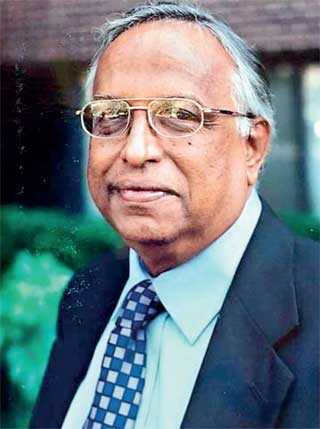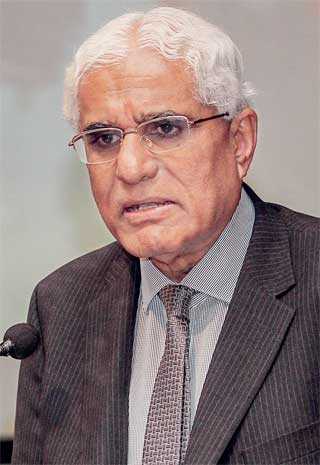Wednesday Apr 23, 2025
Wednesday Apr 23, 2025
Monday, 3 June 2019 00:20 - - {{hitsCtrl.values.hits}}
Delivering the first memorial oration of the late A.S. Jayawardena in Colombo last week, the incumbent Central Bank Governor Dr. Indrajit Coomaraswamy emphasised the need for institutionalising the macroeconomic policy being presently pursued by the bank in order to make it sustainable.
He spoke on ‘Creating Frameworks for Macroeconomic Policy Making and Institutionalising them to Achieve Sustained Improvement in Macroeconomic Fundamentals’ before an audience of ASJ’s contemporaries, colleagues, admirers and students (available at: https://www.youtube.com/watch?v=aFVq18srDG8#action=share ).
ASJ: A man for all seasons
ASJ was a career central banker but he was much more than that. He wore many hats simultaneously during his career spanning for more than five decades. He lent his academic wisdom to students at the old Vidyodaya University as a visiting lecturer in late 1960s. That was where I first met him not as a top economist but as a versatile teacher. 
He was an advisor to the newly-formed Ministry of Plantation Industries in early 1970s advising the Minister on how best the resources belonging to the nationalised plantation sector could be utilised. Then, for a short period, he was handpicked by the Government to head the country’s largest commercial bank, Bank of Ceylon, as its General Manager. Many years later, he functioned as its Chairman too. He was a top bureaucrat in the Government, first as the Secretary to the Ministry of Industries and later as Secretary to the Ministry of Finance.
His longest outside involvement happened to be at the International Monetary Fund as its Alternative Executive Director looking after the interests of India, Sri Lanka, Bangladesh and Bhutan. ASJ used to telling us that IMF was his fourth university after Peradeniya, London and Harvard, helping him to refine his economic thoughts on modern lines.
But his main career was at the Central Bank where he rose from a junior staff officer to Senior Deputy Governor before he was elevated as its Governor in late 1995. He held that post till 2004 successfully going through many calamities which the country as well as the bank had to face during that period converting adversity to prosperity.
When the bank was destroyed by an LTTE bomb in January 1996, instead of lamenting over it, he used the opportunity to reform the bank on modern lines. His motto was that if Phoenix, the mythical bird in ancient Greek mythology, could rise from ashes, so could the bank. He in fact saw to it. I have analysed ASJ’s contributions to Sri Lanka in these numerous capacities in a series of articles to FT and other media and interested readers could have access to them via the links provided in the Box on this page.
Macro-stability
Restoring the macroeconomic fundamentals in Sri Lanka’s economy was something which ran through ASJ’s blood. Hence, Coomaraswamy as the incumbent Governor of the Bank was the best to do justice to him and the title of his oration was both apt and opportune.
Sri Lanka in a historical setting
To understand Sri Lanka’s current economic problems and identify what it should do to overcome them in the future, it is useful to place the country in a historical setting.
At the time of independence in 1948, Sri Lanka was a promising economy in South Asia with capacity to win the economic race along with even a war-ravaged nation like Japan. But over the years, while other comparable countries in East Asia moved forward faster, Sri Lanka slipped away from them relegating itself to the common category known as a developing country. While there were many reasons for this, Coomaraswamy diagnosed macroeconomic issues, called ‘macroeconomic stress’ by economists, as the prime causal factor for this sad fate of the country.
According to him, from 1948 to 1977, the macroeconomic stress was generated by three basic developments.
One was the declining export prices compared to rising or stagnant import prices, known as unfavourable terms of trade. Another was the inability of the country to generate sufficient resources to continue with the liberal social welfare measures like free education and free healthcare system. The third was the dwindling the revenue base of the Government in a background of ballooning consumption expenditure programs.
Loss of real income due to unfavourable terms of trade
Of these causal factors, the worsening terms of trade need further elaboration. Sri Lanka had long depended on the export of tea, rubber and coconut to earn the needed foreign exchange to pay for its imports. However, when the export prices fell compared to those of imports requiring the country to use more export units to buy a unit of imports, a situation known as unfavourable terms of trade.
 |
A.S. Jayawardena |
 |
Central Bank Governor Dr. Indrajit Coomaraswamy delivering the first memorial oration of the late A.S. Jayawardena in Colombo last week – Pic by Chamila Karunarathne |
 |
The economic consequences of this development were twofold. First, it made the real welfare level of Sri Lankans lower than the real output they had produced because that output could buy a lesser amount of import goods. It is like you work harder every year but get paid less so that the real basket of goods that you can have is also smaller.
Second, the widening trade gap and the consequential deficit in the balance of payments ate up the country’s vast foreign exchange reserves which it had inherited from the British. When the rupee came under pressure for devaluation, it was sought to be corrected by imposing a stringent regime of import and exchange controls, further adding to the macroeconomic stress. In my view, the failure to address this issue appropriately was the reason for the other two macroeconomic ailments identified by Coomaraswamy in his oration.
A fiscal sector in stress
After 1977, according to Coomaraswamy, ‘the out of the shape fiscal sector’ was the main trigger point for macroeconomic stress in the country. While revenue continued to fall as a percent of GDP, expenditure was built up by rising defence expenses and salary and pension payments to an expanded public sector. Since the savings within the economy was insufficient to meet the investments, the country had to borrow in increasing amounts in each successive year.
The result was the need for using almost the entirety of the Government revenue to pay interest and repay the principal of the borrowings by the Government. Since new borrowings had to be made to service the old borrowings and finance new investments, it added to the debt stock year after year changing the country’s ‘debt dynamics’ to its disadvantage.
While the fast growing East Asian economies had done the opposite, Sri Lanka emerged as a major macroeconomic spoiler. This was manifested, according to Coomaraswamy, by several ‘highs’ that can be attributed to Sri Lanka: high budget deficit, high inflation, high nominal interest rates and high-valued exchange rate, all are connected to each other.
The result was the emergence of two deficits as the ailment in the macroeconomy: the high budget deficit in the fiscal sector and the high current account deficit in the external sector. If anyone is interested in taking the stress out of the economy, these are the two ailments that have to be cured. Unfortunately, both are outside the purview and the scope of the Central Bank and come within the legitimate economic policy obligations of the Government.
Ailing Sri Lanka’s economy today
Coomaraswamy was very frank about the present state of Sri Lanka’s economy. Economic growth has been falling continuously since 2013 reaching a record low level of 3.2% in 2018, while foreign exchange reserves have been dwindling in the recent past. The potential growth in 2019 has been 5%, but the estimates made by both the Central Bank and IMF have been below that recording a widened output gap. Both have contributed to put pressure on Sri Lanka rupee to depreciate in the market. The situation has been aggravated by the bunching of the repayment of foreign debt in 2019, a legacy of resorting to foreign borrowings in the past to bridge the country’s resource gap.
Though the impact of the recent bomb blasts and religious clashes has not been precisely measured, Coomaraswamy was of the opinion that the reduction in the aggregate demand due to the loss of income should compress the actual growth in 2019.
In the external sector, though the recent clashes did not cause a sudden panic among the foreign investors, there had been continuous capital outflow from the country. The rupee depreciated by 16% in 2018 against the US dollar, but after that correction was made, its further depreciation has been contained. In fact, the rupee has appreciated by a little more than 3% so far in 2019 over its level at end 2018. In the case of foreign exchange reserves, even if a worst case scenario is assumed, there will be sufficient official foreign exchange reserves to meet the foreign debt repayment obligations.
Measures implemented to attain macroeconomic stability
Coomaraswamy then elaborated on the measures which the Central Bank has already taken or propose to take in the immediate future to acquire foreign funding to build the country’s foreign exchange reserves. In this regard, the traditional source for Sri Lanka had been borrowing from international markets in US dollar denominated international sovereign bonds. Ever since Sri Lanka began to tap this market in 2007, there had been many issues of international sovereign bonds by the country in the last 12-year period. Even in 2019, the Central Bank on the request of the Government tapped this market to raise funds for the Government.
Now the bank is proposing to diversify its commercial borrowings into SWAP facilities with India, China and Qatar. In addition, sovereign bonds will be issued in Japanese Yen in the form of Samurai bonds and in Chinese Yuan in Panda bonds. The major breakthrough proposed is to borrow from international markets on the strength of the credit worthiness of the World Bank. Coomaraswamy revealed that bank’s Policy-Based Guarantee or PBG facility is being studied in the Central Bank at present in order to borrow from international markets on the strength of AAA credit rating given to the World Bank. If successful, this would enable Sri Lanka to borrow at about 2% compared to present borrowing rate of 6-7%. However, a caveat is the need for introducing a policy package acceptable to the bank.
Long-term stability depends on restructuring the economy
These measures will surely help Sri Lanka to generate foreign exchange funds to repay its existing loans. This is also what the Central Bank could do as the fiscal agent of the Government. But, this solution is temporary enabling Sri Lanka to overcome the most pressing problem of the day, namely, how to meet the foreign exchange obligations on account of the debt repayment and continuing with the import program.
In this regard, the permanent and long-term solution does not rely on foreign borrowing and repaying the country’s foreign debt or paying for imports. The long-term solution is to restructure the country’s economy giving more priority to investments in sectors that would help the country to earn more foreign exchange. By mobilising funds by borrowing from the international markets, the Central Bank has done its job. Now, it is the Government’s job to take measures to influence the real sector of the economy to produce more. Without such a long-term policy, mere borrowing from international markets to service foreign debt and pay for imports will only increase the country’s indebtedness. No country or an individual can live forever by borrowing for is needs without working. It will push Sri Lanka back to the vicious circle of macroeconomic stress which it is trying to avoid.
Sustaining policy is a challenge
Since Sri Lanka is characterised by policy changes whenever the government changes or whenever a new person assumes leadership even within the same government, good policies adopted by the Central Bank have no permanent existence.
This happened when the political power changed from UNP to UPF in 2004. The previous Government had agreed to replace the Monetary Law Act with a new Central Banking Act and repeal the old Banking Act and introduce a Financial Services Institution Act. However the Government that came to power in 2004 did not think it necessary and shelved both draft legislations.
Hence, it is essential to institutionalise the good macroeconomic stability work which the Central Bank has done. Coomaraswamy devoted the last part of his oration to emphasise this need. Already, an Asset and Liability Management Act has been enacted permitting the Central Bank to raise funds outside the appropriations approved by Parliament whenever the market is conducive to do so and keep them without transferring to the Government in order to repay public debt that is to bunch in a given year. This has been strengthened by a medium term debt management strategy that enables the Central Bank to use available unused space to issue debt on behalf of the Government.
To give strength to the flexible inflation targeting program by making the bank independent from fiscal dominance, a new Monetary Law Act is said to be presented to Parliament for approval soon. These are the institutional improvements that have been already implemented or earmarked to be implemented in the near future. They would certainly make macroeconomic stability measures sustainable but do not assure it since the present Government cannot make unchangeable rules for future governments.
That should come from ‘political consensus building’ and that is completely outside the purview of the Central Bank.
(W.A. Wijewardena, a former Deputy Governor of the Central Bank, can be reached at [email protected].)
Discover Kapruka, the leading online shopping platform in Sri Lanka, where you can conveniently send Gifts and Flowers to your loved ones for any event including Valentine ’s Day. Explore a wide range of popular Shopping Categories on Kapruka, including Toys, Groceries, Electronics, Birthday Cakes, Fruits, Chocolates, Flower Bouquets, Clothing, Watches, Lingerie, Gift Sets and Jewellery. Also if you’re interested in selling with Kapruka, Partner Central by Kapruka is the best solution to start with. Moreover, through Kapruka Global Shop, you can also enjoy the convenience of purchasing products from renowned platforms like Amazon and eBay and have them delivered to Sri Lanka.
Discover Kapruka, the leading online shopping platform in Sri Lanka, where you can conveniently send Gifts and Flowers to your loved ones for any event including Valentine ’s Day. Explore a wide range of popular Shopping Categories on Kapruka, including Toys, Groceries, Electronics, Birthday Cakes, Fruits, Chocolates, Flower Bouquets, Clothing, Watches, Lingerie, Gift Sets and Jewellery. Also if you’re interested in selling with Kapruka, Partner Central by Kapruka is the best solution to start with. Moreover, through Kapruka Global Shop, you can also enjoy the convenience of purchasing products from renowned platforms like Amazon and eBay and have them delivered to Sri Lanka.